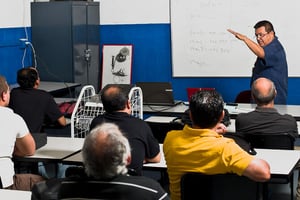Training is essential to helping any organization meet its business objectives. In fact, the number one requirement of any training effort is that it must hold value for the company. Otherwise, training is a waste of time and resources.
From onboarding new employees to conducting road tests with drivers, employee training serves an invaluable purpose and demands proper planning, execution, and follow-up. Unfortunately, this is where training usually fails, especially on the follow-up. Below is a brief list of reasons why training often fails in each of these areas and how you can have better chances of success.
Pre-training Planning
Training events are often conducted with the trainer’s preferences in mind rather than the learner’s preferences. The trainer acts as a lecturer, telling the audience what he or she thinks they need to know, not what the learners deem important.
This approach does a disservice to the learners and the organization because no one wants to sit through a class listening to material one already knows or that is not applicable to the job.
- FIXES TO CONSIDER: When planning a training event, have clearly defined learning objectives. Identify the audience and its learning preferences beforehand. Tailor the content and environment to suit the learners, and above all, make it fun and engaging.
Course Delivery
All learners are different. Each person has different motivations for learning something new, and receives and processes new information differently than others. The challenge for trainers is to utilize multiple delivery modes to make the training appealing to a variety of learning styles.
- FIXES TO CONSIDER: Try a blended learning approach by incorporating multiple delivery methods, such as facilitation, hands-on activities, role plays, etc. Allowing learners to share their experiences is also very effective.
Post-Training Follow-up
Follow-up is the most important phase of training. More time should be spent after the learning event following up with learners and their supervisors to ensure the training is being put into practice on the job. According to Hermann Ebbinghaus’s theory on the “forgetting curve,” more than 70 percent of learning is forgotten within 24 hours after the training, if it is not reinforced.
- FIXES TO CONSIDER: Communicate expectations with supervisors before the training to get their support. Afterwards, follow up with supervisors and learners to ensure the new knowledge or skill is being used on the job. The reinforcement aids retention and helps ensure the training was a success.
CALL TO ACTION
-
Before each training event, determine how the training supports the company's business objectives.
-
Clearly define the learning objectives and target audience in the planning phase.
-
Incorporate blended learning delivery methods to appeal to multiple learning styles.
-
Follow up with learners and supervisors to ensure the new knowledge/skill is being used on the job.
Note: These lists are not intended to be all-inclusive.
This material is intended to be a broad overview of the subject matter and is provided for informational purposes only. Great West Casualty Company does not provide legal advice to its insureds or other parties, nor does it advise insureds or other parties on employment-related issues, therefore the subject matter is not intended to serve as legal or employment advice for any issue(s) that may arise in the operations of its insureds or other parties. Legal advice should always be sought from legal counsel. Great West Casualty Company shall have neither liability nor responsibility to any person or entity with respect to any loss, action, or inaction alleged to be caused directly or indirectly as a result of the information contained herein.Reprinted with permission from Great West Casualty Company.

